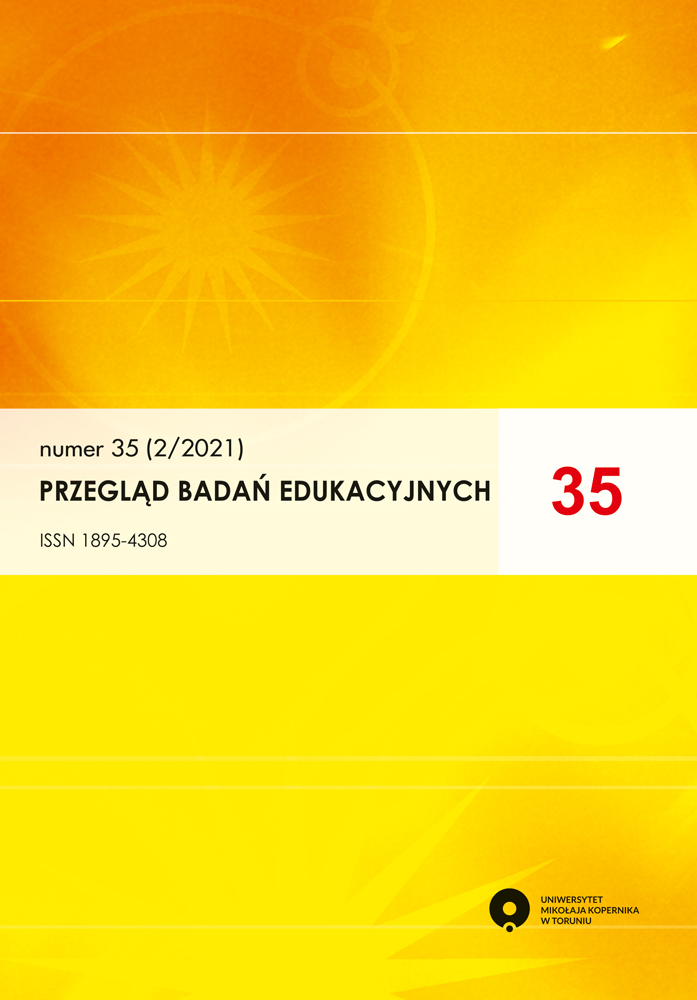Biography of Things – A Ball
DOI:
https://doi.org/10.12775/PBE.2021.031Keywords
history of the ball, ball games, playing with the ball, children's folklore, children's movement culture,Abstract
The presented text is a study of interest in ball as an element of formation and perception of childhood. The research project was embedded in the paradigm of qualitative, interpretative research, where the focus was on the language of the preschooler, which becomes a reflection of the world of physical culture present in the mind of the child – the narrator. The problem of research is focused on the question: To what extent is the ball and its meanings an element of material culture located in the area of physical culture, and in what circumstances is it a determinant of child-specific pre-school folklore? The resulting space of the presented analyzes is an element of the phenomenographic method, where the use of a partially structured interview with preschool children (N = 80) provided the basis for the analysis of the perception and use of a ball in the cognitive theory of a child’s language space. The main conclusions from the research are: 1) for younger children, the ball is more often an attribute of spontaneous play than conventional actions (governed by rules and patterns), 2) for 5- and 6-year-olds, the ball is an artifact of attractive motor activity, training complex motor skills and competition. In middle childhood, the ball is a domain of spontaneous emotionality and an attribute of children’s play, which becomes a material for perceiving, interpreting and situating oneself in a specific culture of movement. The research was conducted in ten municipal kindergartens in the city of Slupsk, Poland in 2016–2019.
References
Attfeld, J. (2000). Wild Things. The Material Culture of Everyday Life. New York: Berg Publishers.
Barankiewicz, J. (1998). Leksykon wychowania fizycznego i sportu szkolnego [Lexicon of Physical Education and School Sports]. Warszawa: WSiP.
Cieślikowski, J. (1985). Wielka zabawa. Folklor dziecięcy. Wyobraźnia dziecięca. Wiersze dla dzieci [Great Play. Children’s Folklore. Children’s Imagination. Children’s Rhymes]. Wrocław–Warszawa–Kraków–Gdańsk–Łódź: Wydawnictwo Zakład Narodowy im. Ossolińskich.
Donnelly, P. (2006). The Sociology of Sport. In: C.D. Bryant, & L.D. Peck (Eds.), 21st Century Sociology (pp. 205–213). Thousand Oaks–London–New Delhi: Sage.
Douglas, M. (2007). Ukryte znaczenia. Wybrane szkice antropologiczne [Hidden Meanings. Selected Anthropological Sketches]. Kęty: Wydawnictwo Marek Drzewiecki. Giulianotti, R. (2005). Sport. A Critical Sociology. Cambridge: Polity Press.
Herzfeld, M. (2008). Zażyłość kulturowa [Cultural Intimacy]. Kraków: Wydawnictwo UJ.
Huizinga, J. (1985). Homo ludens. Zabawa jako źródło kultury [Homo Ludens. A Study of the Play Element in Culture]. Warszawa: Czytelnik.
Ingold, T. (2005). Kultura i postrzeganie środowiska [Culture and the Perception of the Environment]. In: M. Kempny, & E. Nowicka (Eds.), Badanie kultury. Elementy teorii antropologicznej [Culture Study. Elements of Anthropological Theory] (pp. 73–86). Warszawa: Wydawnictwo Naukowe PWN.
Jarvie, G. (2006). Sport, Culture and Society. London–New York: Routledge.
Kardela, H. (1993). Analiza semantyczna wyrażeń języka naturalnego [Semantic Analysis of Expressions in the Natural Language]. In: J. Bartmiński, & R. Tokarski (Eds.), O definicjach i definiowaniu [On Definitions and Defining] (pp. 141–159). Lublin: Wydawnictwo UMCS.
Kleiber, G. (2003). Semantyka prototypu. Kategorie i znaczenie leksykalne [Semantics of Prototypes. Categories and Lexical Meaning]. Kraków: Universitas.
Krajewski, M. (2008). Przedmiot, który uczłowiecza… [An Object Which Humanises…]. Kultura Współczesna, 3(57), 43–54.
Langacker, R.W. (1995). Wykłady z gramatyki kognitywnej [Lectures in Cognitive Grammar]. Lublin: Wydawnictwo UMCS.
Lipiec, J. (2007). Pożegnanie z Olimpią [A Farewell to Olympia]. Kraków: Fall.
Lipoński, W. (1987). Humanistyczna encyklopedia sportu [Humanistic Encyclopaedia of Sport]. Warszawa: Sport i Turystyka.
Lipoński, W. (2004). Rochwist i palant. Studium etnograficzne dawnych i polskich sportów i gier ruchowych na tle tradycji europejskiej [Rochwist and Palant. An Ethnological Study of Old and Polish Sports and Motor Games, in View of the European Tradition]. Poznań: Wydawnictwo Naukowe AWF.
Lipoński, W. (2012). Historia sportu [History of Sport]. Warszawa: Wydawnictwo Naukowe PWN.
Matyja, D. (2000). Leksykon PWN. Sport. [PWN Lexicon. Sport]. Warszawa: Wydawnictwo Naukowe PWN.
Nowakowska-Kępna, I. (1993). Definiowanie znaczenia wyrażeń w kognitywizmie. Wybrane zagadnienia [Defining the Meaning of Expressions in Cognitivism. Selected Issues]. In: J. Bartmiński, & R. Tokarski (Eds.), O definicjach i definiowaniu [On Definitions and Defining] (pp. 161–180). Lublin: Wydawnictwo UMCS.
Rakowski, T. (2008). Przemiany, przesunięcia, przedmioty przejściowe [Transformations, Shifts, Transitional Objects]. Kultura Współczesna, 3(57), 55–72.
Scrambler, G. (2005). Sport and Society History. Power and Culture. Maidenhead: Open University Press.
Słapek, D. (2010). Sport i widowiska w świecie antycznym. Kompendium [Sport and Spectacles in the Ancient World. A Compendium]. Kraków–Warszawa: Wydawnictwo Homini, Wydawnictwa UW.
Szczepska-Pustkowska, M. (2014). Esej o kulturze dziecięcej [Essay on Children’s Culture]. Studia Edukacyjne, 32, 189–210, doi: 10.14746/se.2014.32.12.
Zaleski, M. (2016). A jednak [And Yet]. In: W. Bojda, & A. Nawarecki (Eds.), Piłeczka. Studia o ruchu i melancholii [The Ball. Studies in Movement and Melancholy] (pp. 21–28). Katowice: Wydawnictwo UŚ.
Downloads
Published
How to Cite
Issue
Section
License
Copyright (c) 2021 Educational Studies Review

This work is licensed under a Creative Commons Attribution-NoDerivatives 4.0 International License.
Stats
Number of views and downloads: 595
Number of citations: 0



